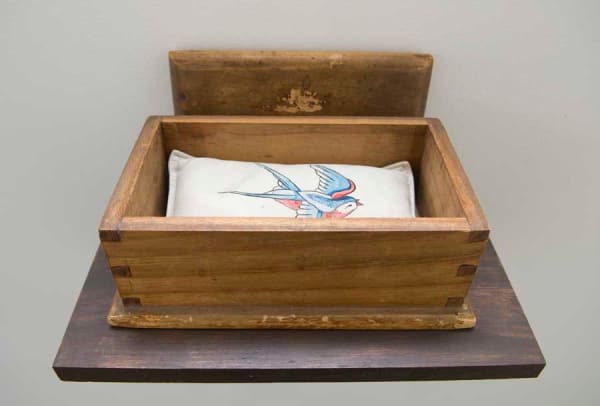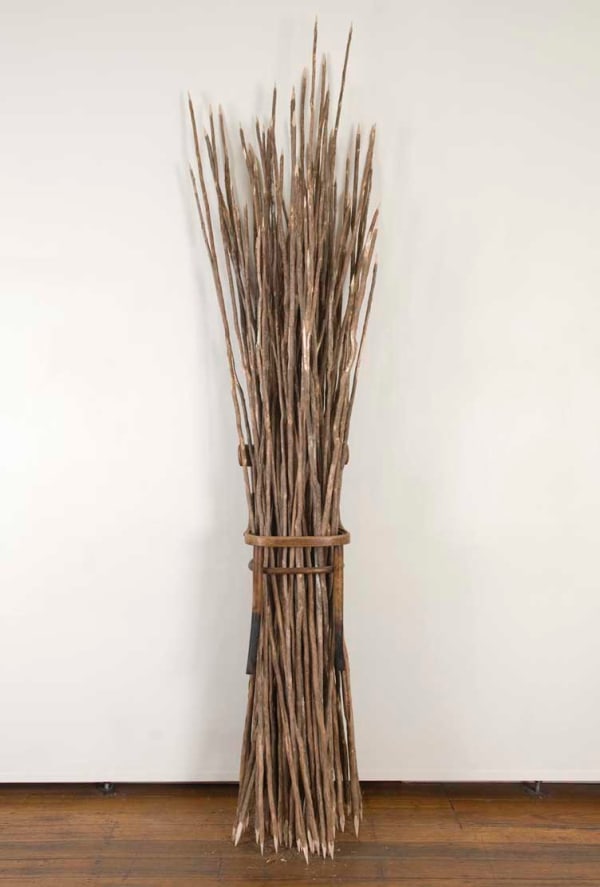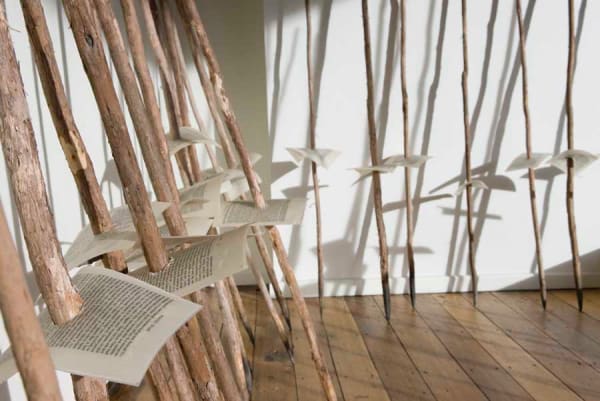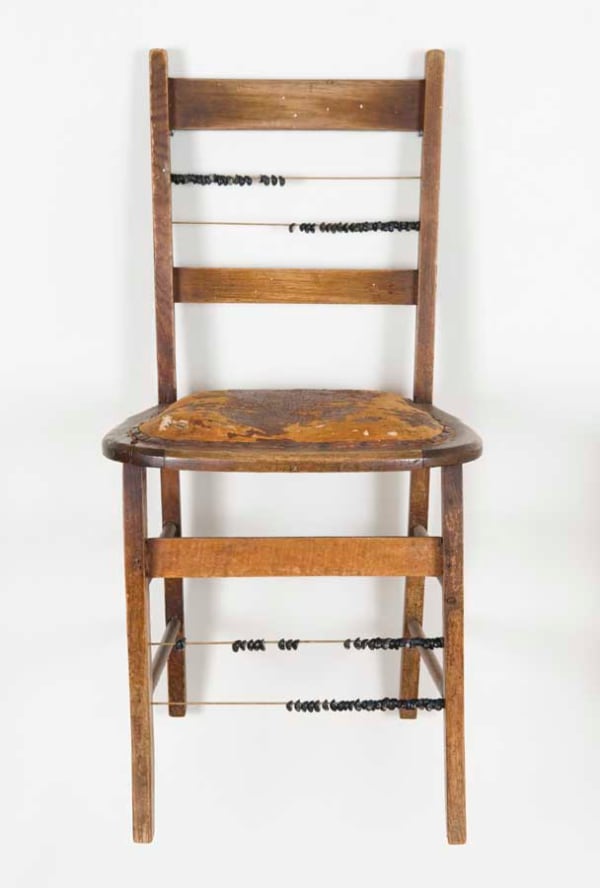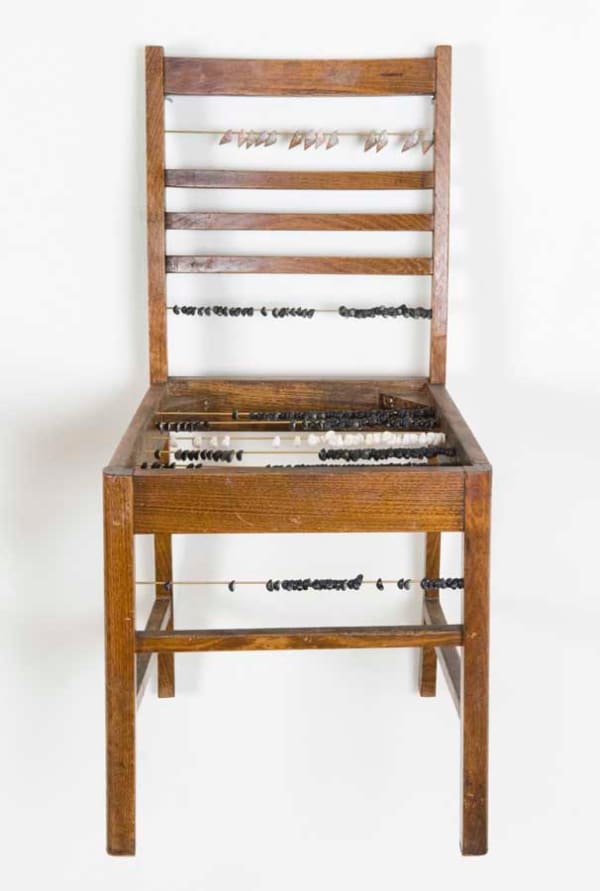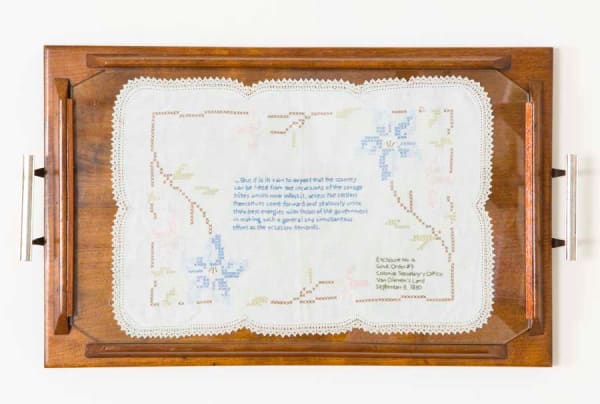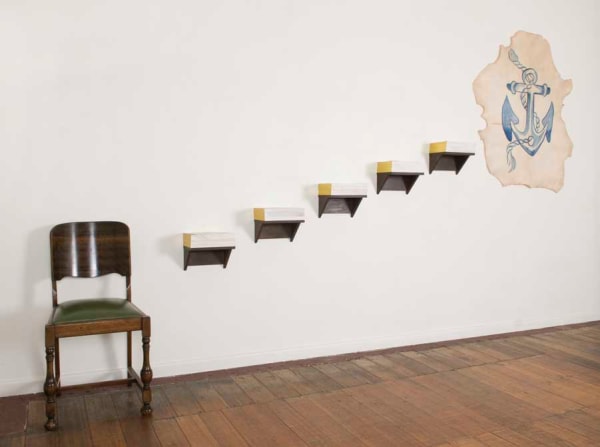Fugitive history
Fugitive History presents recent artworks about historic Tasmanian places and associated stories that are often concealed from the mainstream or everyday. These works gather together as trace evidence of what came before, what happened here. My aim is to offer for fresh reconsideration aspects of cryptic or unresolved histories that bring us to this point of dim memory. These objects and the repetitive actions that created them aim to trigger a rhythmic form of remembering of this island’s colonial-contact inheritance. Collections of objects: spears, shelves, chairs, pins, coal, shells, wallpapers, people and place names manifest in multiple my entrapment in the challengingly elusive past. The objects that make this exhibition: spears, strung shells on wire, coal on rope, antlers, chairs, books represent my own and my family’s patience, our waiting for our different, darker, Indigenous past to be rendered. The works stir between the absences in the records and our presence in places and with people from the early 1800s that were not only tribal or remote.
The works consider different aspects of the impact of colonisation on the island – and by implication for my family: the change and loss of Indigenous Language (Some words for change, 2008); how places have Indigenous histories – here metaphorically concealed in the wrapped renderings of colonial wallpapers (Name sakes, 2008). The coal necklaces Malahide, 2008, Killymoon, 2008 refer in part to the Tasmanian shell necklace tradition, my own gap in missing the inheritance of that tradition in my immediate family, and how the processes of colonisation: farming, hunting, mining are in part responsible for this gap. Shells strung on wires present as abacuses to missing people and lost time (The Missing, 2008, The Wait, 2008, Head count, 2008). Fearful accounts of some incidents against Aboriginal people to 1831 are burnt into Tasmanian oak ‘books’ (Incident reports, 2008), these offer an alternate inroad to place-names, such as New Norfolk or Sorell, otherwise usually innocuous. Witness, 2007 reveals an account of a sister of an Ancestor who witnessed the aftermath of a murderous event - mysteriously dying soon after revealing to a magistrate what she saw.
This art has emerged from various sources: Magistrate reports and newspaper accounts from the early 1800s, Government documents from the 1830 Black Line. Reading lists of VDL baptisms led to the ongoing accounting of Tasmanian Aboriginal children living with non-Aboriginal people from the early to mid 1800s - currently compiled to some 209 children and 91 non-Aboriginal ‘guardians’. Researching the Black Line campaign gave significance, perhaps different than aspired by landholders, to the ‘property’ of people then involved in this military operation to capture Tasmanian Aborigines. Places that have steadfastly held onto their VDL past on their name-plates at their gate posts provide us all with a geographic key to reinterpret today the movements and altercations of our 1810-1835 ancestors, Indigenous or otherwise.
The purpose of an exhibition facilitates and quickens my ongoing research of difficult histories. None of the works present finite or fully comprehended stories, instead they offer me a means to register my own siting at this moment in the search, the unravelling and slow comprehension of colonial contact. Tea-tree, coals and shells of the outdoor-world are placed in this exhibition amidst indoor furnishings to provide a key or coda to deciphering our furtive histories in the real. Our shared pasts linger as accessibly amidst hills and along old roadways of this island as in the texts of the library and archive. To read either well the other is required.
-
 Julie GoughKidnapped, 2007Ink on leather, lead shot & wooden box on shelf23 x 25 x 17 cmSold
Julie GoughKidnapped, 2007Ink on leather, lead shot & wooden box on shelf23 x 25 x 17 cmSold -
 Julie GoughSpear/oar, 2007-08Penguin & black crow shells on wood259 x 10.5 x 5 cmSold
Julie GoughSpear/oar, 2007-08Penguin & black crow shells on wood259 x 10.5 x 5 cmSold -
 Julie GoughSome Tasmanian Aboriginal children living with non-Aboriginal people before 1840, 2008Found chair with burnt tea tree sticksInstalled, approx: 288 x 60 x 50 cmSold
Julie GoughSome Tasmanian Aboriginal children living with non-Aboriginal people before 1840, 2008Found chair with burnt tea tree sticksInstalled, approx: 288 x 60 x 50 cmSold -
 Julie GoughSome words for change, 2008Tea tree sticks (33), paper, palstic & waxInstalled, approx: 220 x 300 x 220 cmPOA
Julie GoughSome words for change, 2008Tea tree sticks (33), paper, palstic & waxInstalled, approx: 220 x 300 x 220 cmPOA -
 Julie GoughHead count, 2008Found chair with brass rods & black crow shells85.5 x 43 x 43 cm
Julie GoughHead count, 2008Found chair with brass rods & black crow shells85.5 x 43 x 43 cm -
 Julie GoughThe wait, 2008Found chair, brass rods with black crow & maireener shells85.5 x 42 x 40 cmSold
Julie GoughThe wait, 2008Found chair, brass rods with black crow & maireener shells85.5 x 42 x 40 cmSold -
 Julie GoughThe simultaneous effort, 2008Embroidered doyley on blackwood tray35 x 60 x 3.5 cmSold
Julie GoughThe simultaneous effort, 2008Embroidered doyley on blackwood tray35 x 60 x 3.5 cmSold -
 Julie GoughName sakes, 2008Tasmanian oak selves holding mystery objects wrapped in reproduced wallpaper patterns form 1850-80’s with the names of corresponding colonial properties gold-leafed onto the shelvesPOA
Julie GoughName sakes, 2008Tasmanian oak selves holding mystery objects wrapped in reproduced wallpaper patterns form 1850-80’s with the names of corresponding colonial properties gold-leafed onto the shelvesPOA -
 Julie GoughBlack-line properties 1, 2008Tea tree spears with paint on timber94 x 196 x 7 cmSold
Julie GoughBlack-line properties 1, 2008Tea tree spears with paint on timber94 x 196 x 7 cmSold -
 Julie GoughKillymoon, 2008Fingal Valley coal necklace, drapped over Northern Midlands antlers200 x 133 x 35 cm
Julie GoughKillymoon, 2008Fingal Valley coal necklace, drapped over Northern Midlands antlers200 x 133 x 35 cm -
 Julie GoughMalahide, 2008Fingal Valley coal necklace, drapped over Northern Midlands antlers200 x 133 x 35 cmSold
Julie GoughMalahide, 2008Fingal Valley coal necklace, drapped over Northern Midlands antlers200 x 133 x 35 cmSold -
 Julie GoughIncident reports, 2008Found Tasmanian oak bookshelf, tea tree stocks, burnt Tasmanian oak240 x 90 x 19 cmSold
Julie GoughIncident reports, 2008Found Tasmanian oak bookshelf, tea tree stocks, burnt Tasmanian oak240 x 90 x 19 cmSold -
 Julie Gough, with Tony ThorneThe missing, 2008Burnt tea tree stick ladder with steel rods & warrener shells190 x 48 x 35 cmSold
Julie Gough, with Tony ThorneThe missing, 2008Burnt tea tree stick ladder with steel rods & warrener shells190 x 48 x 35 cmSold -
 Julie GoughWitness, 2007Found chair, wood, papers with ink on goat vellumInstallation, approx: 180 x 350 x 35 cmPOA
Julie GoughWitness, 2007Found chair, wood, papers with ink on goat vellumInstallation, approx: 180 x 350 x 35 cmPOA -
 Julie GoughEscape 2, 2007Embroidered cotton, timber & chinaDiptych, panel 1: 51 x 51 cm panel 2: 52.5 x 52.5 cmSold
Julie GoughEscape 2, 2007Embroidered cotton, timber & chinaDiptych, panel 1: 51 x 51 cm panel 2: 52.5 x 52.5 cmSold -
 Julie GoughThe chase, 2008Found chaise lounge, leatherette & steel pins97 x 182 x 52 cmSold
Julie GoughThe chase, 2008Found chaise lounge, leatherette & steel pins97 x 182 x 52 cmSold -
 Julie GoughShe was sold for one guinea, 2007Found beaded decoration and book on wooden shelf12 x 13.5 x 20 cmSold
Julie GoughShe was sold for one guinea, 2007Found beaded decoration and book on wooden shelf12 x 13.5 x 20 cmSold

